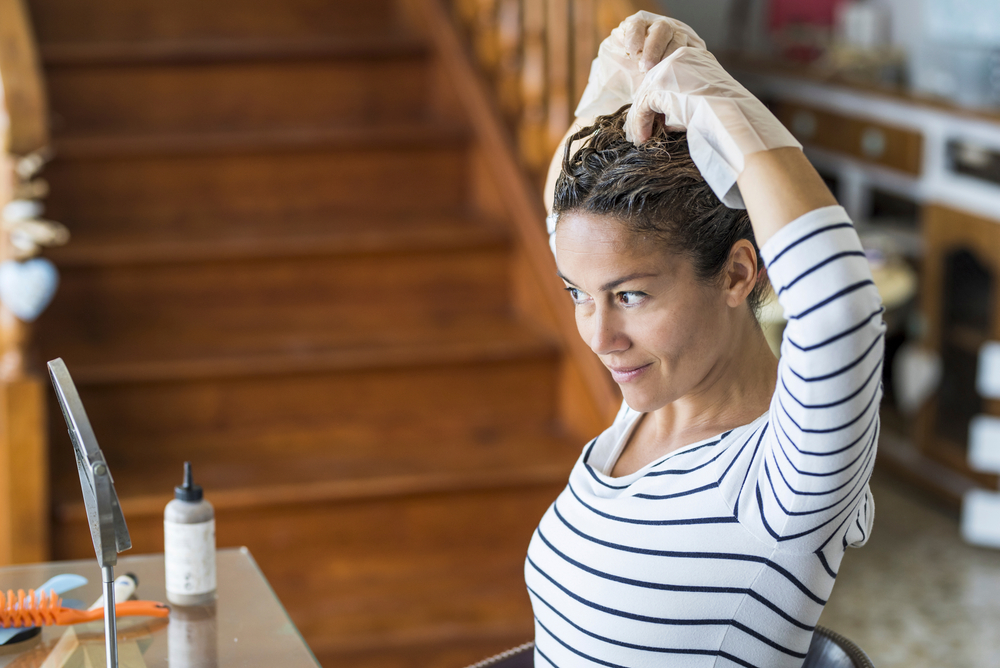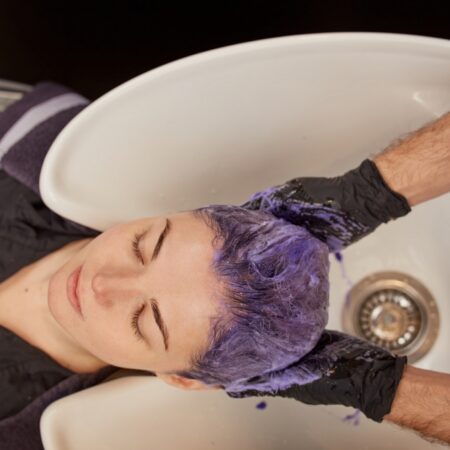If you dye your hair at home or like to do touch-ups to extend your time between salon visits, then toner is a game changer. So, if you’re experimenting with color, toner should definitely be something you’re aware of. But you may wonder how to properly apply it and when to use it.
In this guide, we’re going to help you learn the basics of toner so you can get the most out of your hair dyeing experience.
Toner 101
Here are some frequently asked questions about using hair toner.
What is Toner?
While you may have heard of toner for skin, you may be less familiar with toner for hair, especially if you’re new to dyeing. Toner is basically a product used to treat hair after dyeing to help adjust the color tone. Think of it like a filter to help bring out warmer or cooler notes in your hair color. It can’t make your hair lighter or darker, but it adjusts the color in other ways.
Stylists may use toner immediately after dyeing to dial in the color or within the weeks afterward to help maintain the vibrancy of your dye. Hair color can oxidize when exposed to your daily environment. Depending on the level of air pollution where you live, the minerals in your water (and how often you wash your hair), as well as your exposure to UV, can all affect the tone of your hair color and how long the dye stays fresh looking on you.
Is Toner Only For Bleached Hair?
Definitely not! Bleaching is one of the harshest color treatments for hair, and it can lead to some brassiness or unwanted yellow tones in the color of the hair, so purple shampoo is often used by blondes to balance it out. Toner is really valuable for adjusting any color, though.
For example, red shades can fade more quickly than other dyes, so a toner for red hair can help it maintain its vibrancy longer. Toning can also help reduce orange tones in brown hair as well. Even natural hair colors can sometimes benefit from toning. Graying or silver hair can be treated similarly to blonde hair to increase its vibrancy.
Stronger, salon-level toning can give more dramatic results to alter the undertone of the hair color in a single session rather than simply maintaining it or gradually adjusting it over time. So, if you are looking for something stronger than shampoo, we’ll have more on that below.
Where Can I Buy Toner?
You can buy toner where you buy your usual hair care products. Many brands now sell toning shampoos that are easy to use for daily maintenance. They will often be labeled with the hair color they are meant to be used with and will have instructions on the bottle.
Salon-grade hair toner may need to be purchased from a beauty supply store, but if you get your hair dyed at a salon, you can usually buy your products there, too. Ask your hairdresser what they recommend, and they can tell you the best option for your hair. Hair stylists may also apply toner to your hair themselves after dyeing to adjust your color. Feel free to ask them if you can use the same one at home and how often they recommend you use it between visits.
Should I Tone My Hair at Home?
If you typically dye your hair at a salon, toning is probably part of the process your stylist already goes through. However, toner can gradually fade and lose effectiveness before you’re due for another dye job.
Everyone who dyes their hair should be using products that supports their color to prevent it from fading. The simplest way to do this is by taking good care of your hair. This means using conditioning treatments to support hair that’s dry and bleached. It also means avoiding heat as much as possible and applying heat protection products when you do use heat. Using a shampoo to protect color-treated hair or a color-correcting shampoo is also ideal because it’s simple and effective.
If you already do DIY color at home, you may be tempted to tone it at home, too, with something a little stronger than a toning shampoo to add dimension and get a more professional look. If you go this route, be sure to research the toner that would be ideal for your hair color and texture. Make sure to read the instructions thoroughly and wear gloves when applying the product.
Do You Shampoo After Toner?
Not necessarily. When using toner, you should shampoo first, use toner, and then you can follow up with a conditioning treatment if you’d like, only follow up with shampoo and conditioner if the instructions on your toner specifically instruct you to do so.

How to Apply Salon Toner At Home
If you decide to go for a salon-style toner at home, you’ll need to follow a few important steps. Always make sure you read the instructions of the toner you purchased since ratios and set times may vary between brands.
- Shampoo First: You want to start with clean hair, so shampoo before toning, but don’t condition.
- Towel Dry: If your hair is dripping wet, it’s harder for it to absorb the toner, but it should still be somewhat damp. Make sure it’s a little bit wet before applying your toner.
- Follow Your Toner’s Instructions: Mix and apply the toner according to the instructions and wait the recommended amount of time to let it do its work.
- Wash the Toner Out: After the appropriate amount of time has passed, rinse out the toner. This may mean to simply rinse with water and follow up with conditioner or washing with shampoo and conditioner; ensure you follow the instructions on your specific toner for best results.
So Should You Shampoo After Toning Your Hair?
Quite simply, yes. Shampooing ensures that the color-adjusting chemicals are not left on your hair longer than they should be, which could damage your hair or negatively affect your color. Just as dyeing can be hard on your hair, so can toning.
We recommend you use a moisturizing shampoo after toning and follow it up with a nourishing conditioner. Now is not the time for a harsh, clarifying shampoo. You want your hair to recover and stay healthy so that it can better take the color and styling you want.
Tips for Maintaining Your Hair Color
Toner isn’t something you can apply to your hair every day or even every week, so how do you keep your hair looking vibrant between treatments and fresh dye? If you feel like your color fades or oxidizes really quickly, there are a few things you can try.
Wash Your Hair Less Frequently
If you shampoo your hair every day, you might be washing your color down the drain. Switching to every other day can make a big difference in the life of your color and even help your hair be less brittle. Overwashing can lead to your scalp over-producing oil, so even if you have oily hair, this can be beneficial.
To help you shampoo less, you might want to try protective hair styling, such as different braiding techniques. This helps prevent your hair from getting dirty and requires fewer styling products that need to be washed out of your hair. Thoroughly combing out your hair in the morning and evening will also help remove any dirt and better distribute your hair’s natural oils.
And if you’re struggling with the transition to washing less, dry shampoo can help bridge the gap between wash days.
Pay Attention to Your Water
If you get a lot of mineral build-up on your faucet or showerhead, you may have hard water. This could damage or dry out your hair, preventing it from holding onto color. Try installing a showerhead filter, or if you have a water softener—check your salt levels and add more salt as needed. Many people notice that this improves their dry hair and skin almost immediately.
It’s also recommended to avoid washing your hair with very hot water as that can remove the dye from your hair faster. Basically, hot water opens up your hair’s cuticle, which can lead to the color washing out of it faster.
Use the Right Products
As mentioned a few times in this article, toning shampoos are your best friend for dye maintenance. They are the simplest and least risky way to gently adjust and maintain your hair color between dye jobs.
If you don’t want to use a toning shampoo or haven’t found one that works for you, there are other options. You will still want to use shampoo and conditioner designed for color-treated hair. Dyeing, especially bleaching, causes a lot of damage to your hair. You need products that help revitalize it and put nutrients back into your hair.
Make sure every product you apply to your hair, including styling products, is designed for dyed hair or is, at the very least, color-safe. Otherwise, the products could increase color fading or even react with your dye to cause unwanted tones to develop.
Avoid Heat
It’s worth repeating this advice, too: do not use heat on your hair. Or, at least, minimize your hair’s exposure to heat tools as much as you can. Instead of blow drying your hair, towel and air dry whenever possible. If you love using a curling iron, try overnight rag curls instead. But if you do occasionally use heat, be sure to use a heat protection product that is also color-safe.
Just like dye, heat damages your hair. If you’re doing double damage, it can be hard for your hair to hang on to moisture and maintain a healthy look and feel. Dried-out hair tends to lose color faster.
Have the Best Color of Your Life
Whether you only entrust your hair dye to professionals or love to experiment with dye from the comfort of your home, maintaining that color is essential. Toning can be a really valuable way to get the exact shade that best flatters you and helps extend the life of your color.
We hope our guide has helped you determine what style of toning is best for you and given you some food for thought when it comes to color maintenance.
